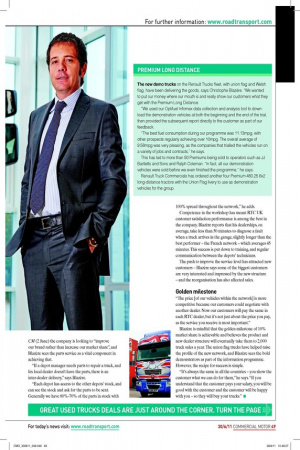United we stand
Page 42

Page 43

If you've noticed an error in this article please click here to report it so we can fix it.
In the space of 12 months, the new MD of Renault Truck Commercials has restructured the dealer network, and turned the Premium demonstration fleet into a real eye-catcher
Words: George Barrow / Images Tom Cunningham You may have seen one of Renault’s unionlag liveried Premiums on the motorway, and if you bought the 28 April issue of CM then you will certainly have seen it on the cover. But you won’t have seen as much of the man behind Renault’s new marketing push, Renault Truck Commercials MD Christophe Blazère.
Blazère joined Renault Truck Commercials (RTC) in the UK in June 2010 and quickly set about restructuring the business to create a better working relationship between the dealerships.
“The union lag trucks were a good idea,” Blazère says. “The people are proud of their lag and we are proud of our trucks, so putting the two together was a great way to unify the 11 sites.”
As well as running the Premium demonstration vehicles, Blazère also brought about some organisational changes to the 11 dealer sites, appointing depot managers at each. The sales structure was also changed, and is now co-ordinated by a sales director with three sales managers responsible for 22 sales peo
ple throughout the network. Responsibility for aftersales now falls to two former depot general managers who work together to get the same level of service across all sites. The changes were implemented in January with the aim of making staff at all the sites more aware of their role within the group rather than their individual dealership.
“Before the depot managers worked for the group, they worked for different companies. Some were Renault, others were maybe Volvo or other companies,” says Blazère. “They were workshop managers or sales managers, and now they continue to do that job but as a depot manager. It’s good for us, good for them, and good for the customer as they already know the business. They no longer work for their garages; they work for Renault Trucks. Their sales results are for the group, not for the individual garages.”
Different mentality
Key to Blazère’s plan was establishing communication between each of the dealers, so that depot managers are aware of the customers in their area and are able to provide the same levels of service.
Blazère says: “There is a completely different mentality [within Renault Truck Commercials], and the customers are happy because if they buy a truck in London, when they get to Cardiff the manager will know him because we discuss them at our monthly meeting of depot managers. You get the same service in London, in Cardiff, in Felixstowe, and the same is true of parts. It’s a big difference. From January we are one company, with one direction and one goal.” The new structure also aims to improve customer care. Renault Trucks MD Marc Martinez told
CM (2 June) the company is looking to “improve our brand rather than increase our market share” , and Blazère sees the parts service as a vital component in achieving that.
“If a depot manager needs parts to repair a truck, and his local dealer doesn’t have the parts, there is an inter-dealer delivery,” says Blazère.
“Each depot has access to the other depots’ stock, and can see the stock and ask for the parts to be sent. Generally we have 60%-70% of the parts in stock with 100% spread throughout the network,” he adds.
Competence in the workshop has meant RTC UK customer satisfaction performance is among the best in the company. Blazère reports that his dealerships, on average, take less than 50 minutes to diagnose a fault when a truck arrives in the garage, slightly longer than the best performer – the French network – which averages 45 minutes. This success is put down to training, and regular communication between the depots’ technicians.
The push to improve the service level has attracted new customers – Blazère says some of the biggest customers are very interested and impressed by the new structure – and the reorganisation has also affected sales.
Golden milestone
“The price [of our vehicles within the network] is more competitive because our customers could negotiate with another dealer. Now our customers will pay the same in each RTC dealer, but it’s not just about the price you pay, as the service you receive is most important.” Blazère is mindful that the golden milestone of 10% market share is achievable and believes the product and new dealer structure will eventually take them to 2,000 truck sales a year. The union lag trucks have helped raise the proile of the new network, and Blazère sees the bold demonstrators as part of the information programme. However, the recipe for success is simple.
“It’s always the same in all the countries – you show the customer what we can do for them,” he says. “If you understand that the customer pays your salary, you will be good with the customer and the customer will be happy with you – so they will buy your trucks.” ■












































